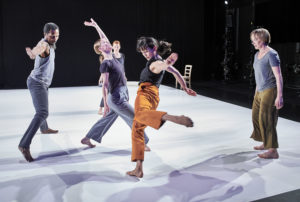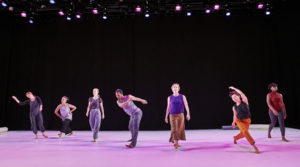Reflections on “In a Rhythm” from Seattle
In a Rhythm went to On the Boards in Seattle WA this past week and a few folks wrote about what they saw! Read on for excerpts from a few…
Bebe Miller Company, ‘In a Rhythm’ at On the Boards

Photographer- Robert Altman
When David Foster Wallace communicates a character, it’s not through describing them outright, but through choosing and arranging words in a way that brings you directly into that character’s psyche—the construction of language itself creates a meta-story inside the plot. Wallace’s potent use of syntax is the impetus for choreographer Bebe Miller’s newest dance work, In a Rhythm, which toured to On the Boards this past weekend. We know this because Miller begins on stage with her dancers, speaking to the audience about her inspiration for the piece, moving effortlessly between memoir and theory, recalling her journey to discover how dance might communicate in that same way—the syntax of movement.
Miller is a masterful public speaker, clear and engaging, yet as warm and intimate as a conversation over coffee. It’s hard to look away from her toward the six dancers who begin to move around her. They move with that casual grace of dancers influenced by the Judson Church Theater lineage, each knee lift and arm swing done at maximum efficiency, only using the exact musculature required and no more. At first, I feel a lot of pressure to perceive the heady concepts Miller discusses. Can I see the dance syntax? Or will I get left in the intellectual dust? What is the meaning, connection and understanding inside these strings of abstract gesture?
The first breakthrough comes when Trebien Pollard gently shoves a chair beneath an unsuspecting Sarah Gamblin, whose knees buckle and she plops down with a laugh as natural as anything. It is not the what that is important, but the how. The way the performers do the movement is remarkable. Though clearly choreographed, they move as if discovering these gestures for the first time, as if each decision were of the moment rather than rote memory. Just as with Wallace’s writing, we’re brought into the dancers’ characters not through the story, but the way the story is told, or in this case, danced.
As In Many Things
By Petra Zanki, On the Boards Blog, March 18, 2018

Photographer- Robert Altman
As in many things, I might be wrong, still, I think this way: good art is not the art that comes easiest to understand. Good art asks questions, plays with us, and frames itself into a certain mold only temporarily. We then create borders and enclosures around it in order to make sense out of it. Forceful art pushes over borders, and leaks out of boxes, refusing to give straight-out answers. Sometimes it swings one back and forth and one doesn’t really know how to respond to it. In those instances, the words remain hanging on the tip of the tongue, weighing it. (Imagine that tremendous weight on the tip of your tongue right now. Now, imagine millions of little ropes piercing your tongue as if Lilliputians put them there with their Lilliputian tiny but mighty needles, and each rope carries millions of little weights hanging from your tongue down, down, down to the ground because of gravity. It hurts a bit, but most importantly, it weighs a lot.)
Sometimes after watching a good theatre or dance performance one remains with no words. One wants to say something, but all it comes out is: aaa.
Sometimes one thinks one grasped something, and then it takes them to another side. Basically, like a driftwood. Although it might not be so bad to be driftwood. So pretty, and weightless, and bare and naked. No worms, no layers, clean, floating in the ocean.
Good art might be frustrating. Like when your friend’s dear one dies, and you want to help, but all you can do is make them a soup. And stare at them while they eat your bland soup, hoping that they will get that you wanted to give the whole universe to them so that they feel better. In that particular moment, it is ok not to know.
Hollering Back at In a Rhythm
By Elissa Favero, On the Boards Blog, March 16, 2018

Photographer- Robert Altman
About her contemporary, the now deceased writer David Foster Wallace, novelist and occasional essayist Zadie Smith asserts, “He was always trying to place ‘relationships between persons’ as the light at the end of his narrative dark tunnels; he took special care to re-create and respect the (often simple) language shared by people who feel some connection with each other.” (“Brief Interviews with Hideous Men: The Difficult Gifts of David Foster Wallace”)
In a Rhythm, Bebe Miller Company’s current show at On the Boards, hinges on metaphors of language: language as words set next to each—arranged and then rearranged in time and space; language aspiring to be natural, revised to look like it rolls out before you, easy, not waving its hands performatively, for attention; and language as negotiation between writer and reader, between one speaker and another. Miller herself acts as a narrative guide, casually introducing the dancers, bringing in Wallace, and novelist Toni Morrison talking to now disgraced journalist Charlie Rose, then Smith on Wallace, and later the rapper Nelly and his song “Country Grammar,” and artists responding to the black teenager Emmett Till who was murdered so brutally, whose death catalyzed the further brutalities and hard-won victories of the Civil Rights movement. Miller queues us into sound as well as words. “Did you hear that note?” she asks several times of the key that’s been stuck intermittently as she first began speaking. She moves in and out of the performance, addressing us and then gone so that music, movement, color, and light become the elements we watch. She’s alerting us, all the while, to choreography as language—the moving body written in time and space, aspiring to be natural. And she’s asking us to work to make sense of it – to make meaning of how the parts work together, like a reader does with an author’s word on the page, or words in the mouth of a speaker.
I didn’t come to any definitive answers about the making sense of. Certainly race is a thread running through, perhaps the major theme of the work. “My grammar be’s ebonics,” Nelly sings back from the year 2000. He performs, with bravado, a rapper’s newfound wealth. Rose questions Morrison about the recurrent theme of race in her novels. We’re all inside of race, she responds. Two dancers of color, Christal Brown and Trebien Pollard, move in duet.
